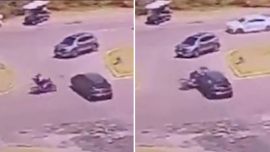As soon as the news agencies began transmitting the image of a man pulling the trigger of a pistol aimed at the face of Vice-President Cristina Fernández de Kirchner, the social networks exploded with messages casting doubts about the attack, installing the idea that it was "staged."
The hashtags #NoLesCreoNada, “#OperetaK”, “#CFKSeVictimiza”and #TodoCirco all became trending topics in the world of Twitter in Argentina, where the first disinformation emerged barely two hours after the attack, reaching users of Facebook, Instagram, Telegram and Whatsapp.
Fernández de Kirchner, 69, was unhurt by the attack from a firearm which did not discharge a bullet despite the trigger being pulled twice. The attack, which took place on September 1 while she was greeting a group of supporters in front of her flat, was condemned on Twitter by most of the country’s political leadership.
But subscribing to the theory that it was all "set up," some reports claimed that the C5N television news channel had reported the attack in their website over three hours before it occurred.
Seeking to verify this claim, AFP managed to discredit it by exploring the source code of the C5N web page, which clearly showed the time of publication of the report, a few minutes after the attack.
Nevertheless, the denials did not prevent over 20,000 sceptics from immediately echoing the disinformation. Well into the small hours of September 2, this version had been translated into Portuguese and was circulating in Brazilian social networks.
Online contamination
Taquion consultants analysed conversations in social networks in Argentina in the hours following the attack, reaching some 19 million users. They observed that out of 264,000 mentions of the attack, the vast majority were supportive of the vice-president (with hashtags like #TodosConCristina) while rejecting political violence. Nevertheless, almost a third (31 percent) "concentrated on disbelief," Sergio Doval, the director of the firm, explained to AFP.
That three out of every 10 persons in the sample immediately questioned an event seen and filmed by multiple witnesses places in relief "the great problem suffered today by the Argentine social fabric" marked by a "profound lack of confidence in the institutions," according to Doval.
For political scientist Diego Reynoso, the director of Political Satisfaction and Public Opinion survey (ESPOP in its Spanish acronym) of San Andrés University, that mistrust takes on a momentum of its own in the era of the social networks, in which "any news can have its opposite number in the form of people or fake news immediately contaminating the discussion, generating doubts and information bubbles," he told AFP.
According to the ESPOP data, Cristina Fernández de Kirchner has a negative image of around 60 percent.
"This also feeds mistrust, making for a hotbed for the circulation of false information," pointed out Reynoso, adding: "Those already predisposed against [Fernández de] Kirchner will consume information placing the attack in doubt and vice-versa."
Either side of ‘la grieta’
Misinformation regarding the attack circulated on both sides of the ‘grieta,’ the term used in Argentina to describe the political polarisation dividing Kirchnerite partisans from the opposition led by the centre-right former president Mauricio Macri.
In the small hours of September 2, when the assailant had already been identified as Fernando Sabag Montiel, word began to spread that he was an employee of opposition leader and Buenos Aires City Mayor Horacio Rodríguez Larreta, information which turned out to be false, as verified by AFP.
The same occurred with two photoshopped images showing Sabag Montiel smiling next to Macri and former Buenos Aires Province governor María Eugenia Vidal.
Further fabricated content sought to identify the accused as a Kirchnerite militant as supposed evidence that the attack was staged for the political benefit of the vice-president.
On September 4 over 50,000 users in Argentina and Brazil assured in the social networks that the weapon used in the attack was really a water pistol.
The very way the networks function in groups reinforcing their own beliefs, facilitates that process.
"The niches are prone to disinformation and fertile ground for 'magic' thinking," pointed out Doval, concluding: "That way it is very difficult to build bridges with the same values helping us to converse constructively."






















Comments